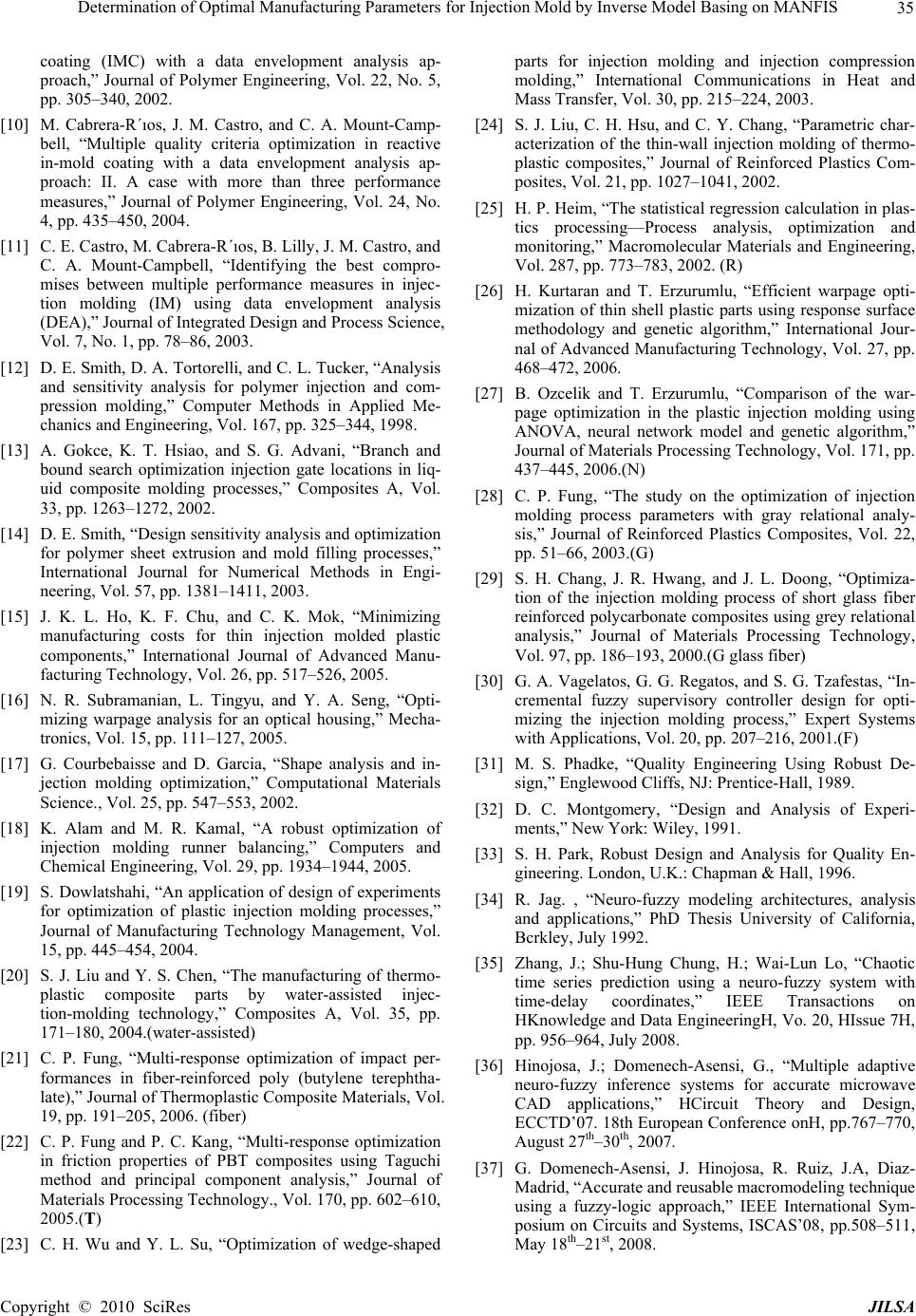
Determination of Optimal Manufacturing Parameters for Injection Mold by Inverse Model Basing on MANFIS 35
coating (IMC) with a data envelopment analysis ap-
proach,” Journal of Polymer Engineering, Vol. 22, No. 5,
pp. 305–340, 2002.
[10] M. Cabrera-R´ıos, J. M. Castro, and C. A. Mount-Camp-
bell, “Multiple quality criteria optimization in reactive
in-mold coating with a data envelopment analysis ap-
proach: II. A case with more than three performance
measures,” Journal of Polymer Engineering, Vol. 24, No.
4, pp. 435–450, 2004.
[11] C. E. Castro, M. Cabrera-R´ıos, B. Lilly, J. M. Castro, and
C. A. Mount-Campbell, “Identifying the best compro-
mises between multiple performance measures in injec-
tion molding (IM) using data envelopment analysis
(DEA),” Journal of Integrated Design and Process Science,
Vol. 7, No. 1, pp. 78–86, 2003.
[12] D. E. Smith, D. A. Tortorelli, and C. L. Tucker, “Analysis
and sensitivity analysis for polymer injection and com-
pression molding,” Computer Methods in Applied Me-
chanics and Engineering, Vol. 167, pp. 325–344, 1998.
[13] A. Gokce, K. T. Hsiao, and S. G. Advani, “Branch and
bound search optimization injection gate locations in liq-
uid composite molding processes,” Composites A, Vol.
33, pp. 1263–1272, 2002.
[14] D. E. Smith, “Design sensitivity analysis and optimization
for polymer sheet extrusion and mold filling processes,”
International Journal for Numerical Methods in Engi-
neering, Vol. 57, pp. 1381–1411, 2003.
[15] J. K. L. Ho, K. F. Chu, and C. K. Mok, “Minimizing
manufacturing costs for thin injection molded plastic
components,” International Journal of Advanced Manu-
facturing Technology, Vol. 26, pp. 517–526, 2005.
[16] N. R. Subramanian, L. Tingyu, and Y. A. Seng, “Opti-
mizing warpage analysis for an optical housing,” Mecha-
tronics, Vol. 15, pp. 111–127, 2005.
[17] G. Courbebaisse and D. Garcia, “Shape analysis and in-
jection molding optimization,” Computational Materials
Science., Vol. 25, pp. 547–553, 2002.
[18] K. Alam and M. R. Kamal, “A robust optimization of
injection molding runner balancing,” Computers and
Chemical Engineering, Vol. 29, pp. 1934–1944, 2005.
[19] S. Dowlatshahi, “An application of design of experiments
for optimization of plastic injection molding processes,”
Journal of Manufacturing Technology Management, Vol.
15, pp. 445–454, 2004.
[20] S. J. Liu and Y. S. Chen, “The manufacturing of thermo-
plastic composite parts by water-assisted injec-
tion-molding technology,” Composites A, Vol. 35, pp.
171–180, 2004.(water-assisted)
[21] C. P. Fung, “Multi-response optimization of impact per-
formances in fiber-reinforced poly (butylene terephtha-
late),” Journal of Thermoplastic Composite Materials, Vol.
19, pp. 191–205, 2006. (fiber)
[22] C. P. Fung and P. C. Kang, “Multi-response optimization
in friction properties of PBT composites using Taguchi
method and principal component analysis,” Journal of
Materials Processing Technology., Vol. 170, pp. 602–610,
2005.(T)
[23] C. H. Wu and Y. L. Su, “Optimization of wedge-shaped
parts for injection molding and injection compression
molding,” International Communications in Heat and
Mass Transfer, Vol. 30, pp. 215–224, 2003.
[24] S. J. Liu, C. H. Hsu, and C. Y. Chang, “Parametric char-
acterization of the thin-wall injection molding of thermo-
plastic composites,” Journal of Reinforced Plastics Com-
posites, Vol. 21, pp. 1027–1041, 2002.
[25] H. P. Heim, “The statistical regression calculation in plas-
tics processing—Process analysis, optimization and
monitoring,” Macromolecular Materials and Engineering,
Vol. 287, pp. 773–783, 2002. (R)
[26] H. Kurtaran and T. Erzurumlu, “Efficient warpage opti-
mization of thin shell plastic parts using response surface
methodology and genetic algorithm,” International Jour-
nal of Advanced Manufacturing Technology, Vol. 27, pp.
468–472, 2006.
[27] B. Ozcelik and T. Erzurumlu, “Comparison of the war-
page optimization in the plastic injection molding using
ANOVA, neural network model and genetic algorithm,”
Journal of Materials Processing Technology, Vol. 171, pp.
437–445, 2006.(N)
[28] C. P. Fung, “The study on the optimization of injection
molding process parameters with gray relational analy-
sis,” Journal of Reinforced Plastics Composites, Vol. 22,
pp. 51–66, 2003.(G)
[29] S. H. Chang, J. R. Hwang, and J. L. Doong, “Optimiza-
tion of the injection molding process of short glass fiber
reinforced polycarbonate composites using grey relational
analysis,” Journal of Materials Processing Technology,
Vol. 97, pp. 186–193, 2000.(G glass fiber)
[30] G. A. Vagelatos, G. G. Regatos, and S. G. Tzafestas, “In-
cremental fuzzy supervisory controller design for opti-
mizing the injection molding process,” Expert Systems
with Applications, Vol. 20, pp. 207–216, 2001.(F)
[31] M. S. Phadke, “Quality Engineering Using Robust De-
sign,” Englewood Cliffs, NJ: Prentice-Hall, 1989.
[32] D. C. Montgomery, “Design and Analysis of Experi-
ments,” New York: Wiley, 1991.
[33] S. H. Park, Robust Design and Analysis for Quality En-
gineering. London, U.K.: Chapman & Hall, 1996.
[34] R. Jag. , “Neuro-fuzzy modeling architectures, analysis
and applications,” PhD Thesis University of California,
Bcrkley, July 1992.
[35] Zhang, J.; Shu-Hung Chung, H.; Wai-Lun Lo, “Chaotic
time series prediction using a neuro-fuzzy system with
time-delay coordinates,” IEEE Transactions on
HKnowledge and Data EngineeringH, Vo. 20, HIssue 7H,
pp. 956–964, July 2008.
[36] Hinojosa, J.; Domenech-Asensi, G., “Multiple adaptive
neuro-fuzzy inference systems for accurate microwave
CAD applications,” HCircuit Theory and Design,
ECCTD’07. 18th European Conference onH, pp.767–770,
August 27th–30th, 2007.
[37] G. Domenech-Asensi, J. Hinojosa, R. Ruiz, J.A, Diaz-
Madrid, “Accurate and reusable macromodeling technique
using a fuzzy-logic approach,” IEEE International Sym-
posium on Circuits and Systems, ISCAS’08, pp.508–511,
May 18th–21st, 2008.
Copyright © 2010 SciRes JILSA